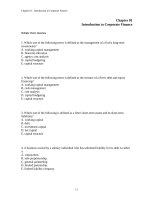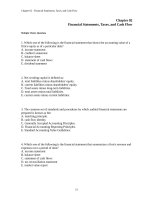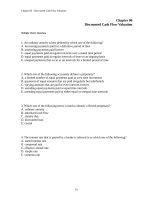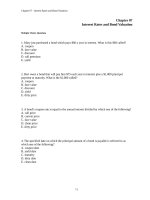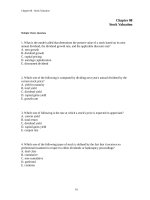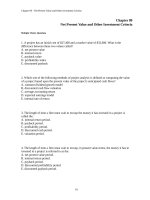test bank fundamentals of corporate finance 8th 8e ch1
Bạn đang xem bản rút gọn của tài liệu. Xem và tải ngay bản đầy đủ của tài liệu tại đây (278.03 KB, 79 trang )
Chapter 01
Goals and Governance of the Corporation
True / False Questions
1. The liability of sole proprietors is limited to the amount of their investment in the
company.
True
False
2. General partners have limited personal liability for business debts in a limited
partnership.
True
False
3. The separation of ownership and management is one distinctive feature of
corporations.
True
False
4. A major disadvantage of partnerships is that they have double taxation of profits.
True
False
5. Financial assets have value because they are claims on the firm's real assets and the
cash that those assets will produce.
True
False
6. Capital budgeting decisions are used to determine how to raise the cash necessary
for investments.
True
False
7. A successful investment is one that increases the value of the firm.
True
False
8. Facebook's decision to spend $700 million to acquire Instagram is an investment
decision.
True
False
1-1
Copyright © 2015 McGraw-Hill Education. All rights reserved. No reproduction or distribution without the prior written consent of
McGraw-Hill Education.
9. Boards of directors are generally appointed by the firm's senior officers.
True
False
10. Financial analysts are involved in monitoring and controlling the risk associated with
investment projects and financing decisions.
True
False
11. The primary goal of any company should be to maximize current period profits.
True
False
12. Maximizing profits is the same as maximizing the value of the firm.
True
False
13. The Dodd-Frank financial reform law in 2010 granted shareholders a binding vote on
executive compensation.
True
False
14. Sole proprietorships face the same agency problems as those associated with
corporations.
True
False
15. Real assets can be intangible assets.
True
False
16. Making good investment and financing decisions is the chief task of the financial
manager.
True
False
17. If a project's value is less than its required investment, then the project is financially
attractive.
True
False
18. GlaxoSmithKline's spending of $6 billion in 2012 on research and development of new
drugs is a capital budgeting decision but not a financing decision.
True
False
19. Volkswagen's issuance of a 2.5 billion euro convertible bond is a financing decision.
True
False
1-2
Copyright © 2015 McGraw-Hill Education. All rights reserved. No reproduction or distribution without the prior written consent of
McGraw-Hill Education.
20. An IOU ("I owe you") from your brother-in-law is a financial asset.
True
False
21. The separation of ownership and management is one distinctive feature of both
corporations and sole proprietors.
True
False
22. Shareholders welcome higher short-term profits even when they damage long-term
profits.
True
False
23. A well-designed compensation package can help a firm achieve its goal of
maximizing market value.
True
False
24. While control of large public companies in the United States is exercised through the
board of directors and pressure from the stock market, in many other countries the
stock market is less important and control shifts to major stockholders, typically
banks and other companies.
True
False
25. Established firms can create value by developing long-term relationships and
maintaining a good reputation.
True
False
Multiple Choice Questions
26. Which one of these is a disadvantage of the corporate form of business?
A. Access to
capital
B. Unlimited personal liability for
owners
C. Limited firm
life
D. Legal
requirements
1-3
Copyright © 2015 McGraw-Hill Education. All rights reserved. No reproduction or distribution without the prior written consent of
McGraw-Hill Education.
27. Which one of the following gives a corporation its permanence?
A. Multiple
owners
B. Limited
liability
C. Corporation
taxation
D. Separation of ownership and
control
28. In a partnership form of organization, income tax liability, if any, is incurred by:
A. the partnership
itself.
B. the partners
individually.
C. both the partnership and the
partners.
D. neither the partnership nor the
partners.
29. Which one of the following would correctly differentiate general partners from limited
partners in a limited partnership?
A. General partners have more job
experience.
B. General partners have an ownership
interest.
C. General partners are subject to double
taxation.
D. General partners have unlimited personal
liability.
1-4
Copyright © 2015 McGraw-Hill Education. All rights reserved. No reproduction or distribution without the prior written consent of
McGraw-Hill Education.
30. Which form of organization provides limited liability for the firm but yet allows the
professionals working within that firm to be sued personally?
A. Limited liability
partnership
B. Limited liability
company
C. Sole
proprietorship
D. Professional
corporation
31. Which of the following is least likely to be discussed in the articles of incorporation?
A. How the firm is to be
financed
B. The purpose of the
business
C. The price range of the shares of
stock
D. How the board of directors is to be
structured
32. When a corporation fails, the maximum that can be lost by an individual shareholder
is:
A. the amount of their initial
investment.
B. the amount of their share of the
profits.
C. their proportionate share required to pay the
corporation's debts.
D. the amount of their personal
wealth.
1-5
Copyright © 2015 McGraw-Hill Education. All rights reserved. No reproduction or distribution without the prior written consent of
McGraw-Hill Education.
33. Which of the following is a disadvantage to incorporating a business?
A. Easier access to financial
markets
B. Limited
liability
C. Becoming a permanent legal
entity
D. Profits taxed at the corporate level and the
shareholder level
34. Unlimited liability is faced by the owners of:
A. corporation
s.
B. partnerships and
corporations.
C. sole proprietorships and general
partnerships.
D. all forms of business
organization.
35. Which one of these statements correctly applies to a limited partnership?
A. All partners share the daily management
duties.
B. All partners enjoy limited personal
liability.
C. General partners have unlimited personal
liability.
D. Taxes are imposed at both the firm and the personal level on
profits earned.
36. In the case of a limited liability partnership, ________ has/have limited liability.
A. only some of
partners
B. only the managing
partner
C. all of the
partners
D. none of the
partners
1-6
Copyright © 2015 McGraw-Hill Education. All rights reserved. No reproduction or distribution without the prior written consent of
McGraw-Hill Education.
37. A board of directors is elected as a representative of the corporation's:
A. top
management.
B. stakeholder
s.
C. shareholder
s.
D. customer
s.
38. The legal "life" of a corporation is:
A. coincidental with that of its
CEO.
B. equal to the life of its board of
directors.
C. permanent, as long as shareholders don't
change.
D. permanent, regardless of current
ownership.
39. When the management of a business is conducted by individuals other than the
owners, the business is most likely to be a:
A. corporatio
n.
B. sole
proprietorship.
C. partnershi
p.
D. general
partner.
40. "Double taxation" refers to:
A. all partners paying equal taxes on
profits.
B. corporations paying taxes on both dividends and retained
earnings.
C. paying taxes on profits at the corporate level and dividends at the
personal level.
D. the fact that marginal tax rates are doubled for
corporations.
1-7
Copyright © 2015 McGraw-Hill Education. All rights reserved. No reproduction or distribution without the prior written consent of
McGraw-Hill Education.
41. A corporation is considered to be closely held when:
A. only a few shareholders
exist.
B. the market value of the shares is
stable.
C. it operates in a small geographic
area.
D. management also serves as the board of
directors.
42. Corporations are referred to as public companies when their:
A. shareholders have no tax
liability.
B. shares are held by the federal or state
government.
C. stock is publicly
traded.
D. products or services are available to the
public.
43. A common problem for closely held corporations is:
A. the lack of access to substantial amounts of
capital.
B. the restriction that shareholders receive only one
vote each.
C. the separation of ownership and
management.
D. an abundance of agency
problems.
44. Corporate managers are expected to make corporate decisions that are in the best
interest of:
A. top corporate
management.
B. the corporation's board of
directors.
C. the corporation's
shareholders.
D. all corporate
employees.
1-8
Copyright © 2015 McGraw-Hill Education. All rights reserved. No reproduction or distribution without the prior written consent of
McGraw-Hill Education.
45. Which one of the following is a financial asset?
A. A corporate
bond
B. A
machine
C. A
patent
D. A
factory
46. Which of the following statements best distinguishes the difference between real and
financial assets?
A. Real assets have less value than financial
assets.
B. Real assets are tangible; financial assets
are not.
C. Financial assets represent claims to income that is generated by
real assets.
D. Financial assets appreciate in value; real assets depreciate
in value.
47. Which one of the following is a real asset?
A. A
patent
B. A personal
IOU
C. A checking account
balance
D. A share of
stock
48. Which one of these is not considered to be a security?
A. Shares of GE
stock
B. A bond traded in the financial
market
C. A mortgage loan issued and held by a
bank
D. A convertible bond issued to the
public
1-9
Copyright © 2015 McGraw-Hill Education. All rights reserved. No reproduction or distribution without the prior written consent of
McGraw-Hill Education.
49. Corporations that issue financial securities such as stock or debt obligations to the
public do so primarily to:
A. increase
sales.
B. become
profitable.
C. increase their access to
funds.
D. avoid double taxation of their
profits.
50. Which one of the following would be considered a capital budgeting decision?
A. Planning to issue common stock rather than issuing
preferred stock
B. Deciding to expand into a new line of products, at a cost of
$5 million
C. Repurchasing shares of common
stock
D. Issuing debt in the form of long-term
bonds
51. Which one of these is a capital budgeting decision?
A. Deciding between issuing stock or debt
securities
B. Deciding whether or not the firm should go
public
C. Deciding if the firm should repurchase some of its
outstanding shares
D. Deciding whether to buy a new machine or repair the old
machine
52. The best criterion for success in a capital budgeting decision would be to:
A. minimize the cost of the
investment.
B. maximize the number of capital budgeting
projects.
C. maximize the value added to the
firm.
D. finance all capital budgeting projects
with debt.
1-10
Copyright © 2015 McGraw-Hill Education. All rights reserved. No reproduction or distribution without the prior written consent of
McGraw-Hill Education.
53. The overall goal of capital budgeting projects should be to:
A. decrease the firm's reliance on
debt.
B. increase the firm's
sales.
C. increase the firm's outstanding shares of
stock.
D. increase the wealth of the firm's
shareholders.
54. An example of a firm's financing decision would be:
A. acquiring a competitive
firm.
B. determining how much to pay for a specific
asset.
C. issuing 10-year versus 20-year
bonds.
D. deciding whether or not to increase the price of its
products.
55. Which of the following is a capital budgeting decision?
A. Should the firm borrow money from a bank or sell
bonds?
B. Should the firm shut down an unprofitable
factory?
C. Should the firm buy or lease a new machine that it is committed to
acquiring?
D. Should the firm issue preferred stock or common
stock?
56. Which of these duties are responsibilities of the corporate treasurer?
A. Financial statements and
taxes
B. Cash management and tax
reporting
C. Cash management and banking
relationships
D. Raising capital and financial
statements
1-11
Copyright © 2015 McGraw-Hill Education. All rights reserved. No reproduction or distribution without the prior written consent of
McGraw-Hill Education.
57. The term "capital structure" refers to:
A. the manner in which a firm obtains its long-term sources of
funding.
B. the length of time needed to repay
debt.
C. whether or not the firm invests in capital budgeting
projects.
D. the types of assets a firm
acquires.
58. Firms can alter their capital structure by:
A. not accepting any new capital budgeting
projects.
B. investing in intangible
assets.
C. issuing stock to repay
debt.
D. becoming a limited liability
company.
59. Which one of these statements is correct?
A. Financial managers have a fiduciary duty to
stockholders.
B. Financial managers are concerned only with funds that flow to
investors.
C. The chief financial officer generally reports directly to the corporate
treasurer.
D. The corporate controller is primarily responsible for overseeing a firm's
cash functions.
60. A firm decides to pay for a small investment project through a $1 million increase in
short-term bank loans. This is best described as an example of a(n):
A. financing
decision.
B. investment
decision.
C. capital budgeting
decision.
D. capital expenditure
decision.
1-12
Copyright © 2015 McGraw-Hill Education. All rights reserved. No reproduction or distribution without the prior written consent of
McGraw-Hill Education.
61. The short-term decisions of financial managers are comprised of:
A. capital structure decisions
only.
B. investment decisions
only.
C. financing decisions
only.
D. both investment and financing
decisions.
62. A block holder is commonly defined as an investor who:
A. owns 5 percent or more of a firm's outstanding
shares.
B. invests in more than one firm within the same
industry.
C. is another
corporation.
D. is also one of the firm's managers or
directors.
63. Which of the firm's financial managers is most likely to be involved with obtaining
financing for the firm?
A. Treasure
r
B. Controll
er
C. Chief Operating
Officer
D. Board of
directors
64. In a large corporation, budget preparation would most likely be conducted by the:
A. treasure
r.
B. controlle
r.
C. chief financial
officer.
D. financial
manager.
1-13
Copyright © 2015 McGraw-Hill Education. All rights reserved. No reproduction or distribution without the prior written consent of
McGraw-Hill Education.
65. In a firm having both a treasurer and a controller, which of the following would most
likely be handled by the controller?
A. Internal
auditing
B. Credit
management
C. Banking
relationships
D. Insuranc
e
66. Which one of the following statements more accurately describes the controller than
the treasurer?
A. Reports directly to the chief executive
officer
B. Monitors capital expenditures to make sure that they are not
misappropriated
C. Responsible for investing the firm's
spare cash
D. Responsible for arranging any issue of
common stock
67. A chief financial officer would typically:
A. report to the treasurer, but supervise the
controller.
B. report to the controller, but supervise the
treasurer.
C. report to both the treasurer and
controller.
D. supervise both the treasurer and
controller.
1-14
Copyright © 2015 McGraw-Hill Education. All rights reserved. No reproduction or distribution without the prior written consent of
McGraw-Hill Education.
68. Which one of these determines the minimum acceptable rate of return on a capital
investment?
A. The available alternative investment
opportunities
B. The profit margin of the
existing firm
C. The rate of return on the firm's outstanding
shares
D. The rate of return on risk-free debt
securities
69. A financial analyst in a corporation may be involved with all of the following EXCEPT:
A. analyzing a new investment
project.
B. monitoring
risk.
C. managing investment of the company's
cash.
D. purchasing the firm's plant and
equipment.
70. Investment banks like Morgan Stanley or Goldman Sachs:
A. collect deposits and relend the cash to corporations and
individuals.
B. help companies sell their securities to
investors.
C. design and sell insurance policies for
businesses.
D. lend to corporations and investors in commercial
real estate.
71. The primary goal of corporate management should be to:
A. maximize the number of
shareholders.
B. maximize the firm's
profits.
C. minimize the firm's
costs.
D. maximize the shareholders'
wealth.
1-15
Copyright © 2015 McGraw-Hill Education. All rights reserved. No reproduction or distribution without the prior written consent of
McGraw-Hill Education.
72. A corporate board of directors should provide support for the top management team:
A. under all
circumstances.
B. in all decisions related to cash
dividends.
C. only when the board approves of management's
actions.
D. if shareholders are pleased with the firm's
performance.
73. Which of the following appears to be the most appropriate goal for corporate
management?
A. Maximizing market value of the company's
shares
B. Maximizing the company's market
share
C. Maximizing the current profits of the
company
D. Minimizing the company's
liabilities
74. How may a reduction in cash dividends be in the best interests of current
shareholders?
A. A reduction of cash dividends is always in the best interests of current
shareholders.
B. The firm will have available cash to increase current investment and
future profits.
C. Reduced dividends increase managerial compensation, thus increasing managers'
motivation.
D. A reduction of cash dividends cannot be in the best interests of current
shareholders.
1-16
Copyright © 2015 McGraw-Hill Education. All rights reserved. No reproduction or distribution without the prior written consent of
McGraw-Hill Education.
75. Financial managers should only accept investment projects that:
A. increase the current profits of the
firm.
B. can increase the firm's market
share.
C. earn a higher rate of return than the firm currently earns on its
existing projects.
D. earn a higher rate of return than shareholders can get by investing on
their own.
76. Agency problems can least be controlled by:
A. establishing good internal controls and
procedures.
B. designing compensation packages that align manager's goals with those of the
shareholders.
C. corporate
governance.
D. electing senior managers to the board of
directors.
77. Which one of these best defines the objective of a well-functioning financial market?
A. Establishing accurate security
prices
B. Creating higher security
prices
C. Eliminating short-selling
profits
D. Increasing shareholder value by any means
possible
78. Corporate raiders will be looked upon most favorably if they:
A. divide up large profitable
entities.
B. take actions that increase current shareholder
wealth.
C. create value for themselves through their
actions.
D. change the capital structure of a firm by increasing
its debt.
1-17
Copyright © 2015 McGraw-Hill Education. All rights reserved. No reproduction or distribution without the prior written consent of
McGraw-Hill Education.
79. Ethical decision making by management has a payoff for shareholders in terms of:
A. improved capital
structure.
B. enhanced firm reputation
value.
C. increased managerial
benefits.
D. higher current dividend
payments.
80. Ethical decision making in business:
A. reduces the firm's
profits.
B. requires adherence to implied rules as well as
written rules.
C. is not in the best interests of
shareholders.
D. is less important than good capital budgeting
decisions.
81. A corporate director:
A. is selected by and can be removed by
management.
B. can be voted out of power by the
shareholders.
C. has a lifetime appointment to the
board.
D. is selected by a vote of all corporate
stakeholders.
82. In which of the following organizations would agency problems be least likely to
occur?
A. A sole
proprietorship
B. A
partnership
C. A
corporation
D. A closely held
corporation
1-18
Copyright © 2015 McGraw-Hill Education. All rights reserved. No reproduction or distribution without the prior written consent of
McGraw-Hill Education.
83. Sole proprietorships resolve the issue of agency problems primarily by:
A. avoiding excessive expense
accounts.
B. discharging those who violate the
rules.
C. allowing owners to share the cost of their actions
with others.
D. forcing owners to bear the full cost of their
actions.
84. Agency problems can best be characterized as:
A. dislike of firm's bondholders by its
equityholders.
B. differing incentives between managers and
owners.
C. spending of corporate
resources.
D. friction between managers and
employees.
85. Which of the following is least likely to represent an agency problem?
A. Lavish spending on expense
accounts
B. Plush remodeling of the executive
suite
C. Excessive avoidance of
taxes
D. Executive incentive compensation
plans
86. When managers' compensation plans are tied in a meaningful manner to the profits
of the firm, agency problems:
A. can be
reduced.
B. will be
created.
C. are shifted to other
stakeholders.
D. are eliminated entirely from
the firm.
1-19
Copyright © 2015 McGraw-Hill Education. All rights reserved. No reproduction or distribution without the prior written consent of
McGraw-Hill Education.
87. A firm's reputation:
A. has no
value.
B. is an important firm
asset.
C. is irrelevant to
shareholders.
D. can be easily restored once
damaged.
88. Which of the following groups is least likely to be considered a stakeholder of the
firm?
A. Governme
nt
B. Custome
rs
C. Competito
rs
D. Employe
es
89. A manager's compensation plan that offers financial incentives for increases in
quarterly profitability may create agency problems in that:
A. the managers are not motivated by
personal gain.
B. the board of directors may claim the
credit.
C. short-term, not long-term profits become
the focus.
D. investors desire stable
profits.
1-20
Copyright © 2015 McGraw-Hill Education. All rights reserved. No reproduction or distribution without the prior written consent of
McGraw-Hill Education.
90. One continuing problem with managerial incentive compensation plans is that:
A. the plans increase agency
problems.
B. managers prefer guaranteed
salaries.
C. their effectiveness is difficult to
evaluate.
D. the plans do not reward
shareholders.
91. Which one of the following forms of compensation is most apt to align the interests of
managers and shareholders?
A. A fixed
salary
B. A salary that is linked to current company
profits
C. A salary that is paid partly in the form of the
company's shares
D. A salary that is linked to the company's
market share
92. Which of the following is a real asset?
A. A
patent
B. A share of stock issued by Bank of New
York
C. An IOU ("I owe you") from your brotherin-law
D. A mortgage loan taken out to help pay for a
new home
93. Which one of these statements is correct?
A. A dollar received next year has the same value as a dollar
received today.
B. Risky cash flows are more valuable than certain
cash flows.
C. Smart investment decisions create more value than smart financing
decisions.
D. Corporate governance is
irrelevant.
1-21
Copyright © 2015 McGraw-Hill Education. All rights reserved. No reproduction or distribution without the prior written consent of
McGraw-Hill Education.
94. Short selling involves selling a security:
A. you do not
own.
B. that you have owned for less than one
year.
C. at a price below current market
value.
D. for less than you originally paid to
purchase it.
Essay Questions
95. What general factors may influence the decision of whether to organize as a sole
proprietorship, a partnership, or a corporation?
96. Discuss why corporations typically exhibit separation of ownership and management,
as distinguished from sole proprietorships or partnerships.
1-22
Copyright © 2015 McGraw-Hill Education. All rights reserved. No reproduction or distribution without the prior written consent of
McGraw-Hill Education.
97. Why is limited liability such an important aspect to investors?
98. Provide at least three examples each of real and financial assets that might appear
on the balance sheet of General Motors.
99. Distinguish between a firm's capital budgeting decisions and its financing decisions
by giving examples of each.
1-23
Copyright © 2015 McGraw-Hill Education. All rights reserved. No reproduction or distribution without the prior written consent of
McGraw-Hill Education.
100 Discuss the interrelationship between a firm's financing and its capital structure
.
decisions.
101 Who are the financial managers in large corporations?
.
102 Fritz and Frieda went to business school together 10 years ago. They have just been
.
hired by a midsized corporation that wants to bring in new financial managers. Fritz
studied finance, with an emphasis on financial markets and institutions. Frieda
majored in accounting and became a CPA 5 years ago. Who is more suited to be
treasurer and who controller? Briefly explain.
1-24
Copyright © 2015 McGraw-Hill Education. All rights reserved. No reproduction or distribution without the prior written consent of
McGraw-Hill Education.
103 Provide examples of managerial goals other than the maximization of market value.
.
104 Provide at least two recent examples of unethical behavior by company executives
.
and the results of that behavior.
105 Develop a case for the interrelationship of ethical decision making by corporate
.
management and profitability of the firm.
1-25
Copyright © 2015 McGraw-Hill Education. All rights reserved. No reproduction or distribution without the prior written consent of
McGraw-Hill Education.

